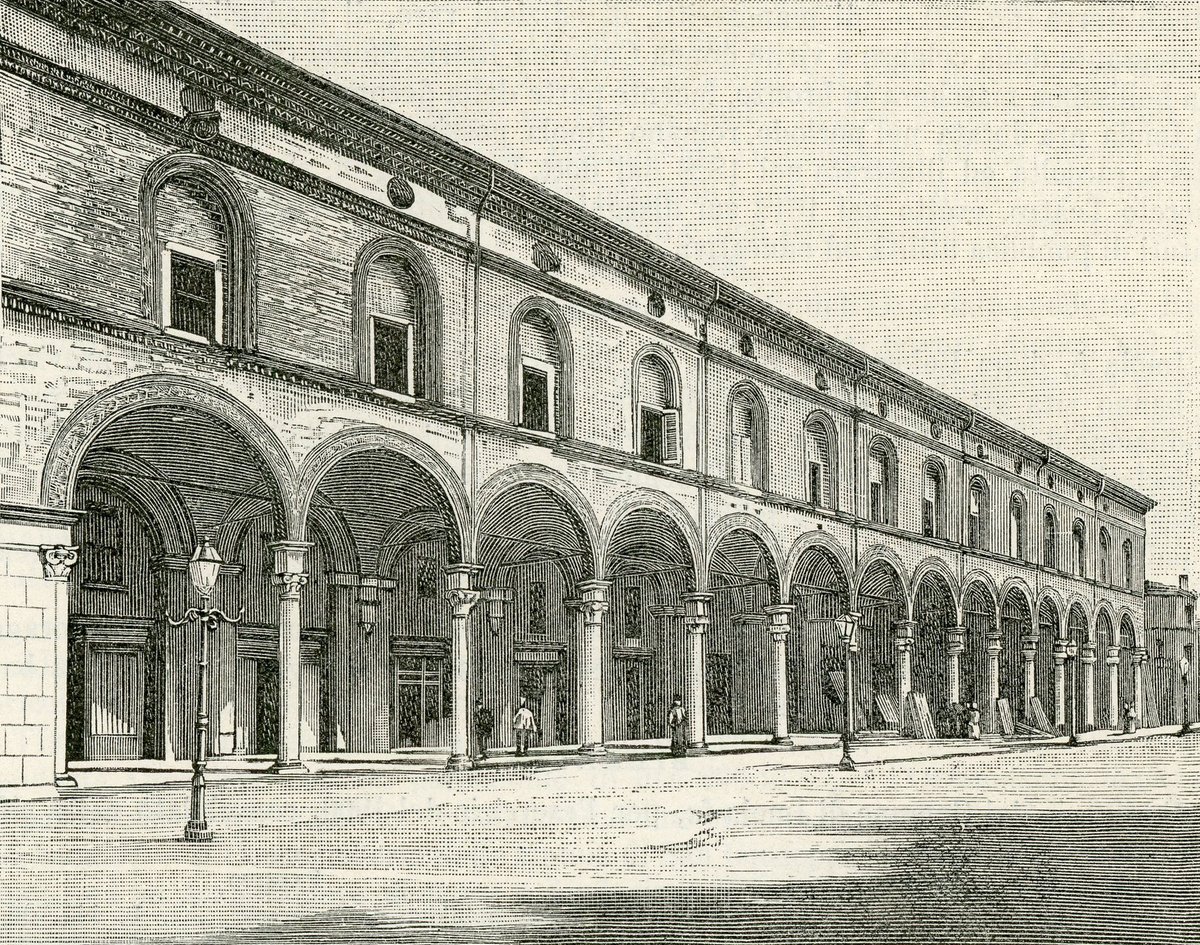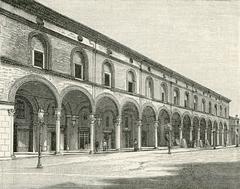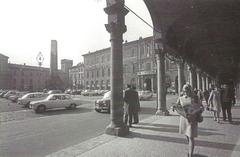
Palazzo Sersanti: Visiting Hours, Tickets, and Complete Historical Guide to Imola’s Renaissance Landmark
Introduction
Located in the heart of Imola, Italy, Palazzo Sersanti is a magnificent Renaissance palace that serves as a living testament to the town’s historical, architectural, and cultural evolution. Commissioned in the late 15th century by Count Girolamo Riario—nephew of Pope Sixtus IV—and later closely associated with the Sersanti family, the palace encapsulates centuries of artistic ambition, civic pride, and vibrant community life. Overlooking Piazza Matteotti, Imola’s main square, Palazzo Sersanti continues to be a central hub for cultural events, exhibitions, and civic engagement (Leggilanotizia.it; ImolAmo Blog).
This comprehensive guide details the palace’s rich history, architectural features, cultural significance, practical information for visitors, and travel tips to ensure a rewarding visit to one of Emilia-Romagna’s most treasured sites.
Table of Contents
- Historical Overview
- Visiting Palazzo Sersanti: Practical Information
- Palazzo Sersanti in Imola’s Cultural Life
- Frequently Asked Questions (FAQ)
- Plan Your Visit and Stay Connected
- References
Historical Overview
Origins and Construction
Palazzo Sersanti’s construction began in 1483 under the direction of Count Girolamo Riario, a powerful Renaissance lord intent on expressing Imola’s prosperity and his own status through grand architecture. Although the original project was never fully completed, the palace’s robust Renaissance design—with harmonious proportions and a striking terracotta façade—became a defining feature of Imola’s urban landscape (Leggilanotizia.it; ImolAmo Blog).
Architectural Features and Evolution
Palazzo Sersanti is a quintessential example of early Italian Renaissance architecture in northern Italy. The façade is characterized by a rhythmic series of rounded arches, supported by sandstone columns and embellished with terracotta ornamentation. The ground floor’s portico not only provided shelter for lively markets but also reinforced the palace’s civic prominence. The upper floors, with their elegant windows and decorative stonework, reflect the refined tastes of Imola’s Renaissance elites (Radici Molesi; ImolAmo).
Over the centuries, Palazzo Sersanti underwent various transformations, including periods of commercial use, adaptation for civic functions, and extensive restoration efforts to preserve its Renaissance splendor.
Ownership, Restoration, and Artistic Heritage
The palace was named for the Sersanti family, prominent local merchants and bankers who acquired it in the 19th century. Restoration campaigns, especially in 1888, sought to recover Renaissance features and stabilize the structure (Radici Molesi). Today, ownership lies with the Fondazione Cassa di Risparmio di Imola, which continues to promote preservation and cultural activities. The palace houses noteworthy art collections, including works by local artists and ceramics, accessible during guided tours and special events (Leggilanotizia.it).
Palazzo Sersanti in Imola’s Civic History
Strategically located on Piazza Matteotti and the ancient Via Emilia, Palazzo Sersanti has been central to Imola’s political and social life for centuries. It served as the seat for influential clubs, including the Circolo Cittadino Sersanti, and has hosted commemorations, exhibitions, and community gatherings, particularly during key historical moments such as World War II (Il Nuovo Diario).
Visiting Palazzo Sersanti: Practical Information
Visiting Hours and Tickets
Palazzo Sersanti does not maintain fixed daily opening hours. Instead, it welcomes visitors primarily during special events, exhibitions, and guided tours. Typical visiting hours for these occasions are between 10:00 AM and 6:00 PM. For the most current schedule, consult the Bologna Welcome website or Visit Imola.
- Tickets: Admission is often free during cultural events, while guided tours may require a nominal fee. Advance booking is recommended, especially for group visits.
- Contact: Check the official Imola tourism website for event calendars and ticketing details.
Accessibility
- Ground floor and portico: Wheelchair accessible.
- Upper floors: May have limited access due to historical stairways.
- Assistance: Available upon request; visitors with mobility needs are encouraged to contact the venue in advance.
Guided Tours and Special Events
Guided tours, often provided by local students during public events, offer deeper insights into the palace’s history, art, and architecture. The palace is also a frequent venue for major conferences, art exhibitions, and educational programs (Comune di Imola; Geolab APS).
Travel Tips and Nearby Attractions
- Location: Piazza Matteotti, Imola, Italy.
- Access: A short walk from Imola’s train station; public parking is available nearby.
- Best time to visit: Spring and autumn, coinciding with major cultural events like the Giornate FAI d’Autunno (Il Nuovo Diario).
- Nearby sites: Rocca Sforzesca (medieval fortress), Palazzo Tozzoni, Imola Cathedral, Chiesa del Suffragio, and the Autodromo Enzo e Dino Ferrari.
Palazzo Sersanti in Imola’s Cultural Life
Cultural Hub and Community Engagement
Since 1930, Palazzo Sersanti has been home to the Circolo Cittadino Sersanti, a club dedicated to promoting artistic and cultural activities. The palace regularly hosts art exhibitions, lectures, and public gatherings that foster Imola’s vibrant cultural scene (Bologna Welcome).
Palazzo Sersanti’s grand hall displays works by painter Anacleto Margotti and serves as a backdrop for major civic and international events, such as the European TWINS4EU project, which brought together participants from Imola, Medicina, and Pola for discussions on fundamental rights and sustainability (Comune di Imola).
Architectural Heritage and Urban Identity
With its 14-arch portico, elegant terracotta façade, and prominent position on Piazza Matteotti, Palazzo Sersanti is a visual anchor for Imola’s historic center. The palace forms part of an architectural ensemble alongside the Town Hall, Chiesa del Suffragio, and Palazzo Gamberini, embodying the city’s Renaissance heritage and urban vitality (Visitare Imola; Il Resto del Carlino).
Educational Value
During public events, local students often serve as guides, sharing stories and insights into the palace’s history. This intergenerational approach strengthens community ties and ensures that knowledge of Imola’s heritage is passed down (Il Nuovo Diario).
Frequently Asked Questions (FAQ)
Q: What are Palazzo Sersanti’s visiting hours?
A: The palace is open during scheduled events and by appointment. Check the official tourism site for current hours.
Q: How much are tickets?
A: Admission is often free; guided tours may require a small fee.
Q: Are guided tours available?
A: Yes, especially during public openings and by prior arrangement.
Q: Is Palazzo Sersanti accessible for visitors with disabilities?
A: The ground floor and portico are accessible; some upper floors may be challenging.
Q: What attractions are nearby?
A: Rocca Sforzesca, Imola Cathedral, Palazzo Tozzoni, Chiesa del Suffragio, and the Autodromo Enzo e Dino Ferrari.
Plan Your Visit and Stay Connected
To make the most of your visit:
- Check event calendars on the Imola tourism website and Visit Imola for updated hours and event listings.
- Download the Audiala app for audio guides and the latest information.
- Follow official channels and social media for news and updates on cultural events.
- Combine your visit with other historic sites in Imola for a full day of exploration.
References
- Leggilanotizia.it
- ImolAmo Blog
- Bologna Welcome
- Il Nuovo Diario
- Comune di Imola
- Geolab APS
- Il Nuovo Diario
- Visit Imola
- Radici Molesi
- Visitare Imola
- Il Resto del Carlino
Experience the living heritage of Imola with a visit to Palazzo Sersanti—where Renaissance artistry, civic tradition, and contemporary culture come together. Download the Audiala app, plan your tour, and follow official social media for the latest updates.


